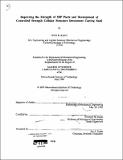| dc.contributor.advisor | Emanuel M. Sachs. | en_US |
| dc.contributor.author | Bang, Won B | en_US |
| dc.contributor.other | Massachusetts Institute of Technology. Dept. of Mechanical Engineering. | en_US |
| dc.date.accessioned | 2007-07-18T14:04:26Z | |
| dc.date.available | 2007-07-18T14:04:26Z | |
| dc.date.copyright | 1996 | en_US |
| dc.date.issued | 1996 | en_US |
| dc.identifier.uri | http://hdl.handle.net/1721.1/38200 | |
| dc.description | Thesis (S.M.)--Massachusetts Institute of Technology, Dept. of Mechanical Engineering, 1996. | en_US |
| dc.description | Includes bibliographical references (p. 79). | en_US |
| dc.description.abstract | Three Dimensional Printing (3DP) is a rapid prototyping process that creates a three dimensional part directly from computer models by printing a sequence of two dimensional layers. In this research, the strength of 3DP parts were improved by using different "print styles" (the way binder is deposited on the powder bed in creating a 3DP part) for use in investment casting process. The print styles that were created optimized line to line interaction between the printed lines, binder overlap, and the amount of unprinted powder surrounding the printed features. The strength of the parts are measured in three different axes (X-fast, Y-slow, Z). The strength improved by factors of 2, 8, and 7 for the three different axes. A controlled strength cellular structure investment casting shell that enables the creation of a metal part without any stress related defects has been created. The ceramic shell has an open cell frame structure with thin inner shell where the metal casting is poured. The flexibility of the 3DP technology applied to controlled strength cellular structure investment casting shell will incorporate all the advantages of 3DP to investment casting (Sach 1992, ASME) as well as reduction in material consumption, controlled heat transfer, permeability, and of course controlled strength to eliminate stress related defects. The cellular structure ceramic mold is designed to withstand the pouring pressures of the molten metal and survive the handling during processing yet fail when the stresses from the contracting metal becomes excessive. The 3DP molds are usually 60% porous and cellular structure investment casting shells consist of only 35% of the 3DP material per volume. A controlled strength cellular structure investment casting shell is designed to fail when excessive stress is applied to the shell structure. The stress on the casting shell is caused by the shrinkage of the metal part. The controlled strength investment casting shell has an open cellular structure frame with a thin inner shell where the metal casting will form. | en_US |
| dc.description.statementofresponsibility | by Won B. Bang. | en_US |
| dc.format.extent | 101 p. | en_US |
| dc.language.iso | eng | en_US |
| dc.publisher | Massachusetts Institute of Technology | en_US |
| dc.rights | M.I.T. theses are protected by copyright. They may be viewed from this source for any purpose, but reproduction or distribution in any format is prohibited without written permission. See provided URL for inquiries about permission. | en_US |
| dc.rights.uri | http://dspace.mit.edu/handle/1721.1/7582 | |
| dc.subject | Mechanical Engineering. | en_US |
| dc.title | Improving the strength of 3DP parts and development of controlled strength cellular structure investment casting shell | en_US |
| dc.title.alternative | Improving the strength of Three Dimensional Printing parts and development of controlled strength cellular structure investment casting shell | en_US |
| dc.type | Thesis | en_US |
| dc.description.degree | S.M. | en_US |
| dc.contributor.department | Massachusetts Institute of Technology. Department of Mechanical Engineering | |
| dc.identifier.oclc | 53362372 | en_US |
